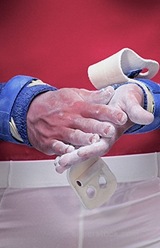Let's do something really stupid: Let's avoid using chalk for lifting. Let's always go barehanded. Especially for cleans. 
One of the worst side-effects is the torn callus. When you have a solid grip on the bar, it prevents slippage and helps prevent the torn calluses. I have a persistent callus on the inside of my thumb just below the knuckle. Every time I clean a heavy barbell without chalk, I have torn it off. I don't usually notice this until after the WOD when it starts to hurt. Chalking my hands before lifting helps prevent this.
Sweaty hands can't grip the bar well, and a heavy load might normally slip out of your grip. If you are forgoing chalk, you might want to wear your steel toed boots for when the bar drops on your toes. Ouch. The other downside to chalk is the fingerprints all over the gym floor, right next to the sweat angels. Most big box gyms ban chalk. The managers know that if they get rid of the chalk, the big scary guys will go with it, leaving more room to sign up people who prefer heavy gossip to heavy lifting. Like Mark Ripettoe says, "If your gym doesn’t allow you to use chalk then it’s not a gym, it’s a spa."
But Crossfit isn't about posing, and chalk has it's rightful place near the bumper plates. Use it. Don't make a mess and lift with respect given to others. Whether it's accurate or not, chalk is the symbol of the serious strength athlete. By the way, it's not chalk anymore, but magnesium carbonate. And by using it, it can lead to greater control of the barbell and higher totals.


2 comments:
You forgot to mention that most serious athletes put their game face on while staring in the chalk bucket ;)
Good post.
Post a Comment